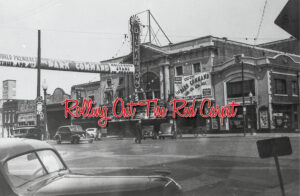| story by | |
| OPEN A PDF OF THE ARTICLE |
The first free state newspaper in the Kansas Territory promoted the free state cause to its readers, mostly in New England, to recruit them to the territory, ultimately increasing tension among free state and proslavery supporters before the Civil War.

A Herald of Freedom
In the 1850s, newspapers were the primary medium for sharing local news and information about events in the larger world with a community. During the territorial period in Lawrence, six different newspapers were published at various times: Daily Lawrence Republican, Lawrence Republican, Herald of Freedom, Kansas Tribune, Kansas Daily Tribune and the Kansas Free State. Of these titles, the Herald of Freedom was unique because it was subsidized by the Massachusetts Emigrant Aid Co. (later the New England Emigrant Aid Co.).
The Massachusetts Emigrant Aid Co. was incorporated by the state of Massachusetts “for the purpose of assisting emigrants to settle in the West.” The founders of the company intended to benefit emigrants in the following ways.
- • diminish the expenses of the journey and protect from fraud and delay, provide food and shelter at the lowest price while they construct their habitation, save their families from exposure in the wilderness by the company being the real pioneer
- • advise and assist the company’s agents in securing a good location in the West
- • the immediate advantage of the press, the school and the church so the morals and intelligence of their children shall not be forfeited by a life of semibarbarianism, as often happens to settlers in the West.
The company proposed the country would benefit through “extending the area of freedom by creating new free states” and “by reducing the pooer (sic) population of our Eastern Cities—necessarily vicious here probably will be virtuous there—vice often comes from poverty.” This is an interesting and somewhat self-righteous assessment of the poor, which was common in the 19th century.
The plan of operation of the Massachusetts Emigrant Aid Co. included receiving bids to convey 20,000 settlers (an overly optimistic number) to the company’s selected settlement, building a boarding house to accommodate 300 people, constructing a steam sawmill and a grist mill, and, pertinent to this article, establishing: “as soon as they shall have suitable room for the same a weekly paper devoted to Liberty, Liberation & good morals—which shall be open to letters of the Co’s exploring agents for unfolding to the people the resources of the new country & aiding in various ways the interests of the new settlement.”

A Herald of Freedom
The newspaper was intended to be a means to recruit potential settlers from its readers in Massachusetts and New England. It also ended up increasing free state support for Kansas by reporting the various conflicts between the anti- and proslavery forces in the territory.
LOCAL MATTERS
Our Local Advertisers – Making a Positive Impact
The first issue of the Herald of Freedom was actually published in Conneautville, Pennsylvania, with a Wakarusa dateline on Oct. 21, 1854. The next issue was dated Jan. 6, 1855, from the Lawrence, Kansas, Territory. The publisher of the newspaper was George Washington Brown. He had been editor of the Conneautville Courier and espoused free soil sentiments in his editorials. Brown negotiated with the Massachusetts Emigrant Aid Co. to publish the Herald of Freedom, the first free state newspaper in Kansas Territory He promoted the free state cause to the readers of the paper, many of whom were in New England.
In a letter dated Jan. 10, 1856, Brown wrote to Hiram Hill, an investor in land in the new territory, from Williamsburg, Hampshire County, Massachusetts. He thanked him for his gift of $15 and informed him he was sending him 10 copies of the Herald of Freedom. Brown reported:
- “The circulation of our paper is increasing at an unparalleled vote, showing that the people are bound to sustain it. I feel confident that so long as we have a free and untrimmed press in Kansas, one which has the ability and independence to proclaim our wrongs to the world and inspire our friends with hope we have nothing to apprehend for the result of the struggle now waging between freedom and despotism.”
Lawrence was soon subject to a violent attack. The sacking of Lawrence occurred on May 21, 1856, when proslavery settlers, led by Douglas County Sheriff Samuel J. Jones, attacked and ransacked Lawrence, Kansas. While Brown was being held with other free state supporters in Lecompton after the raid, he wrote to Eli Thayer, a founder of the Emigrant Aid Co., in Worcester, Massachusetts, on June 4, 1856, describing the aftermath of the attack.
- “You have learned ere this of my arrest at Kansas City, while on the way to the Territory, by an armed mob, and of my confinement here under guard of United States troops, …. You will also have learned of the destruction of the Emigrant Aid Co’s Hotel at Lawrence, of the burning of Doct. Robinson’s dwelling; the stealing of his papers, books and so forth; of his won imprisonment; and of the destruction of my two hand presses, the power, press, all my type and fixtures for my extensive news and jobbing office, also my private papers and documents, and my extensive miscellaneous and law library, embracing over a thousand volumes of the choicest publication of the times.
- The Demon of the slave power a rampant today, and all because they come in the name of the law, clothed with authority of the federal government.”
Later in the same letter, Brown wrote that if the newspaper’s supporters would provide generous support, the Herald of Freedom “will again rise from its ashes and will continue as formerly a terror to tyrants.”
While the newspaper was increasing its readership in New England in 1856, the content of the Herald of Freedom and the Kansas Free State, also published in Lawrence, were condemned by a Douglas County grand jury. This jury found that these two newspapers:
- “offered publications of a most inflammatory and seditious character denying the legality of the Territorial authorities and advising and commanding forcible resistance to the same according to the popular mind and rendering life and property unsafe even to the extent of advising assassination as a last resort.”
The grand jury voted to “recommend that steps be taken whereby said nuisances maybe removed.” Obviously, the members of this grand jury were proslavery supporters. However, these newspapers continued publishing.
In the Nov. 19, 1859, issue, the editor reported that the Herald of Freedom was acquiring new readers.
- “Through the active operation of numerous personal friends and relatives scattered over the country, who took agencies for the paper, and many others who sympathized with the principles enunciated, our list was suddenly swelled to EIGHT THOUSAND. The effect of this large list was visible in the unprecedented emigration of the spring of 1857, nearly every emigrant of whom was bound for Lawrence. Our friends at Kansas City, Leavenworth, etc., were in the habit of remarking, as passengers left the steamboat and inquired the direction to this city, that ’It seems as if eastern people are unconscious of any other place in Kansas than Lawrence.’ It was almost true, and we are vain enough to believe that our circulation of 8,000 copies throughout the States, and passed from hand to hand, each having at least six readers, and the long extracts from its columns in all the leading papers of the country, did much towards bringing Lawrence into still wider notoriety.”
The Herald of Freedom ceased publication at the end of 1859. It fulfilled the purpose of its founding by the Massachusetts Emigrant Aid Co. of establishing “a weekly paper devoted to Liberty, Liberation & good morals—which shall be open to letters of the Co’s exploring agents for unfolding to the people the resources of the new country.” Many settlers came to Kansas Territory as a result of its description of the land in the West. However, its impact in sharing news about the proslavery atrocities in Lawrence is immeasurable in helping increase tensions between free state and slavery supporters that led to the Civil War.
- Note: Most issues of the Herald of Freedom are available on the Library of Congress’s digital newspaper site Chronicling America. It can be accessed at The Kansas Herald of Freedom. [volume](Wakarusa, Kan. Territory), 21 Oct. 1854. Chronicling America: Historic American Newspapers . Lib. of Congress.




